Child Behaviour: Observation, Assessment, and Teaching Methods
VerifiedAdded on 2022/10/11
|6
|906
|16
Homework Assignment
AI Summary
This assignment delves into the multifaceted realm of child behaviour, offering insights into establishing routines, understanding guiding principles like social equality and mutual respect, and preventing avoidable behavioural difficulties. It outlines effective guidelines, explores reinforcement techniques, and provides methods for observing and collecting data on children's behaviour. The document also examines the reasons behind inappropriate behaviour and emphasizes the importance of consistency in interactions and handling behavioural issues. It further explores the development and implementation of behaviour support plans, methods of assessment, and strategies for supporting students, including ESL teaching methods. This assignment provides a comprehensive overview of child behaviour, offering practical strategies and theoretical frameworks for educators and caregivers.
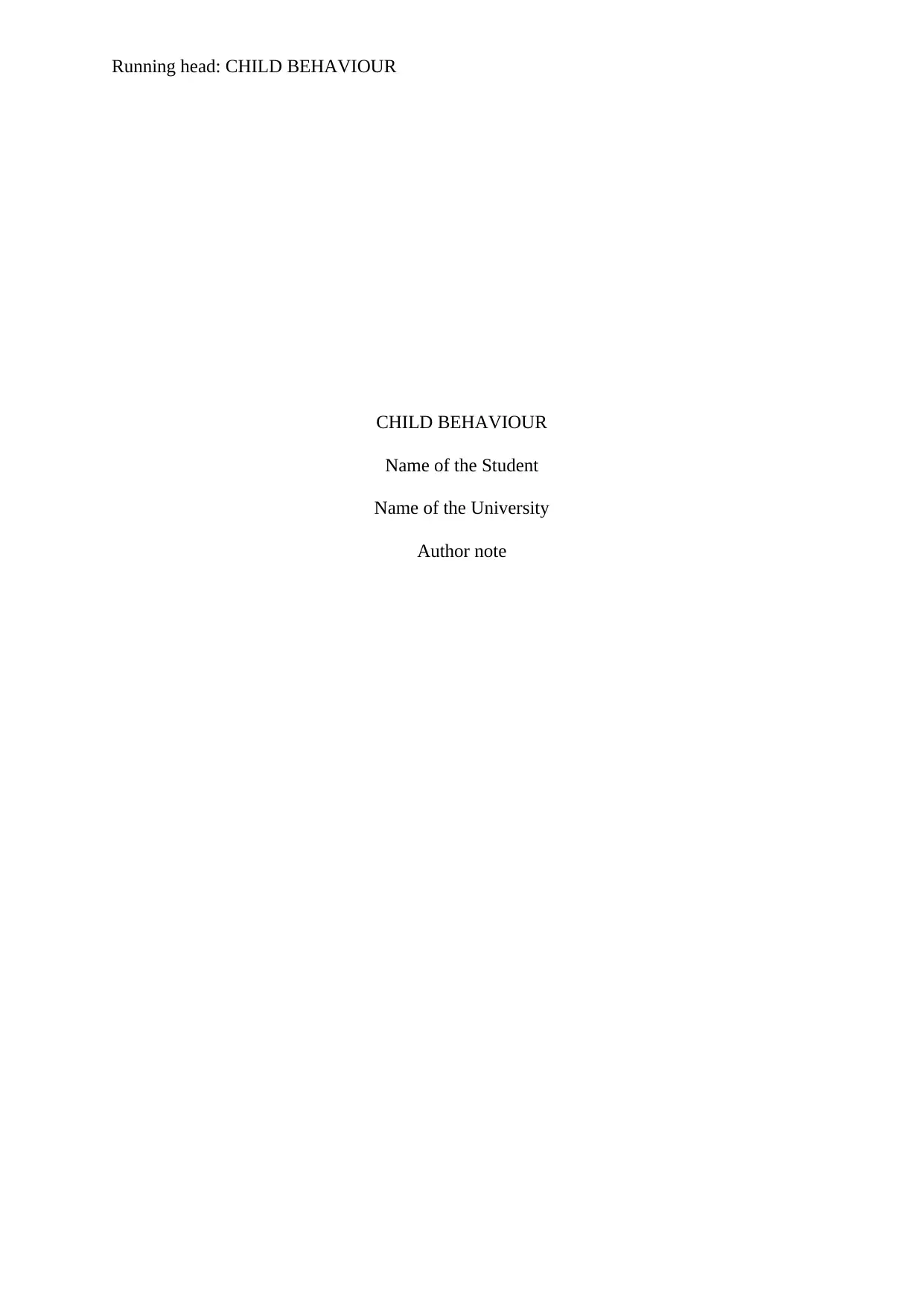
Running head: CHILD BEHAVIOUR
CHILD BEHAVIOUR
Name of the Student
Name of the University
Author note
CHILD BEHAVIOUR
Name of the Student
Name of the University
Author note
Paraphrase This Document
Need a fresh take? Get an instant paraphrase of this document with our AI Paraphraser

1CHILD BEHAVIOUR
1. Routine is important in supporting appropriate behaviour in class because it gives
children the ability to predict what is approaching next in their lives. This is
particularly applicable for children who are in their developmental period when
children do not possess the abstract concept of time.
Example: If students receive their recess period at the same time every day and are
required to finish their work before that, they will try to finish all their work on time
and develop it into a habit.
2. The principles relating to children and guiding behaviour are,
i) Social equality: This principle states that all human beings are equal in worth
and dignity, and everyone is accepted the way they are.
ii) Mutual respect: This principle states that if the teachers show love and respect
towards their students, the students are more likely to respect them as well.
iii) Trust: This principle states that the children must know that they can trust their
teachers and other concerned adults, which in turn would promote emotional
security.
iv) Cooperation: This principle states that being cooperative and flexible with
students proves beneficial as the students feel important and could share their
views in an unselfish way.
v) Shared responsibility: This principle states that giving students age appropriate
responsibility helps them become more independent and trust adults better.
3. Active listening – Listening to someone with full attention and providing feedback. It
proves that you understand the speaker.
Passive listening – Listening without reacting or providing feedback or allowing the
speaker to speak without interrupting.
1. Routine is important in supporting appropriate behaviour in class because it gives
children the ability to predict what is approaching next in their lives. This is
particularly applicable for children who are in their developmental period when
children do not possess the abstract concept of time.
Example: If students receive their recess period at the same time every day and are
required to finish their work before that, they will try to finish all their work on time
and develop it into a habit.
2. The principles relating to children and guiding behaviour are,
i) Social equality: This principle states that all human beings are equal in worth
and dignity, and everyone is accepted the way they are.
ii) Mutual respect: This principle states that if the teachers show love and respect
towards their students, the students are more likely to respect them as well.
iii) Trust: This principle states that the children must know that they can trust their
teachers and other concerned adults, which in turn would promote emotional
security.
iv) Cooperation: This principle states that being cooperative and flexible with
students proves beneficial as the students feel important and could share their
views in an unselfish way.
v) Shared responsibility: This principle states that giving students age appropriate
responsibility helps them become more independent and trust adults better.
3. Active listening – Listening to someone with full attention and providing feedback. It
proves that you understand the speaker.
Passive listening – Listening without reacting or providing feedback or allowing the
speaker to speak without interrupting.
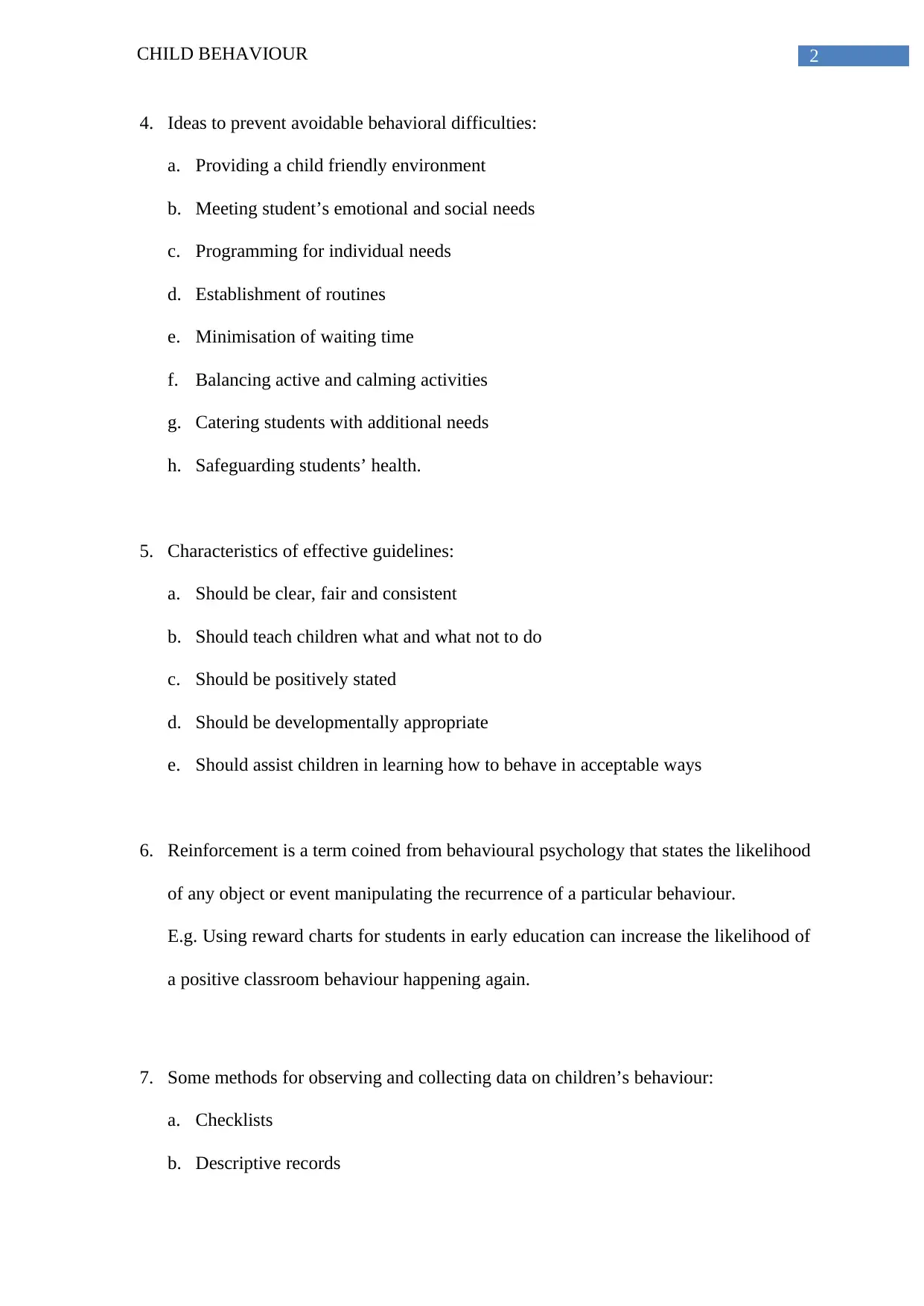
2CHILD BEHAVIOUR
4. Ideas to prevent avoidable behavioral difficulties:
a. Providing a child friendly environment
b. Meeting student’s emotional and social needs
c. Programming for individual needs
d. Establishment of routines
e. Minimisation of waiting time
f. Balancing active and calming activities
g. Catering students with additional needs
h. Safeguarding students’ health.
5. Characteristics of effective guidelines:
a. Should be clear, fair and consistent
b. Should teach children what and what not to do
c. Should be positively stated
d. Should be developmentally appropriate
e. Should assist children in learning how to behave in acceptable ways
6. Reinforcement is a term coined from behavioural psychology that states the likelihood
of any object or event manipulating the recurrence of a particular behaviour.
E.g. Using reward charts for students in early education can increase the likelihood of
a positive classroom behaviour happening again.
7. Some methods for observing and collecting data on children’s behaviour:
a. Checklists
b. Descriptive records
4. Ideas to prevent avoidable behavioral difficulties:
a. Providing a child friendly environment
b. Meeting student’s emotional and social needs
c. Programming for individual needs
d. Establishment of routines
e. Minimisation of waiting time
f. Balancing active and calming activities
g. Catering students with additional needs
h. Safeguarding students’ health.
5. Characteristics of effective guidelines:
a. Should be clear, fair and consistent
b. Should teach children what and what not to do
c. Should be positively stated
d. Should be developmentally appropriate
e. Should assist children in learning how to behave in acceptable ways
6. Reinforcement is a term coined from behavioural psychology that states the likelihood
of any object or event manipulating the recurrence of a particular behaviour.
E.g. Using reward charts for students in early education can increase the likelihood of
a positive classroom behaviour happening again.
7. Some methods for observing and collecting data on children’s behaviour:
a. Checklists
b. Descriptive records
⊘ This is a preview!⊘
Do you want full access?
Subscribe today to unlock all pages.

Trusted by 1+ million students worldwide
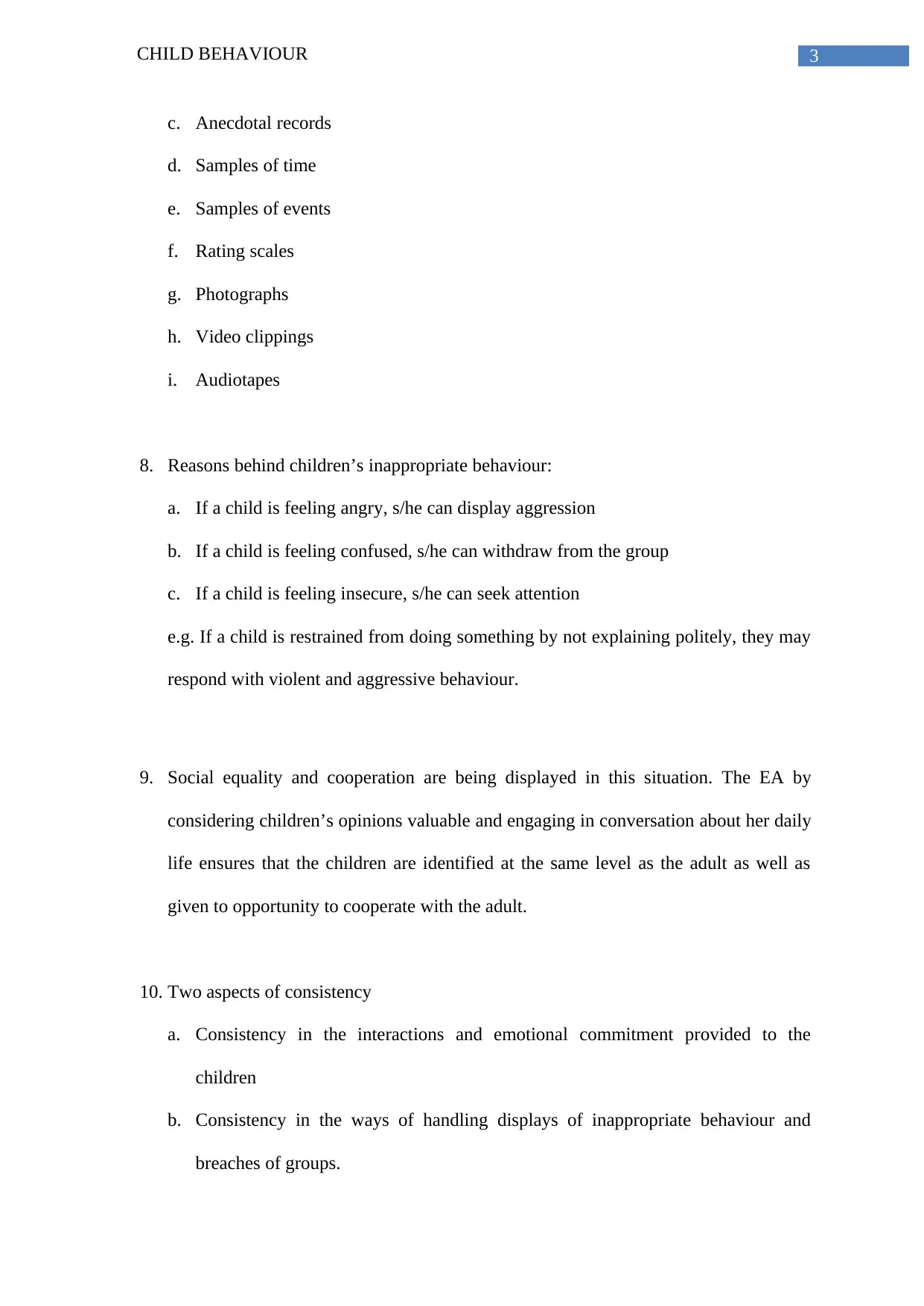
3CHILD BEHAVIOUR
c. Anecdotal records
d. Samples of time
e. Samples of events
f. Rating scales
g. Photographs
h. Video clippings
i. Audiotapes
8. Reasons behind children’s inappropriate behaviour:
a. If a child is feeling angry, s/he can display aggression
b. If a child is feeling confused, s/he can withdraw from the group
c. If a child is feeling insecure, s/he can seek attention
e.g. If a child is restrained from doing something by not explaining politely, they may
respond with violent and aggressive behaviour.
9. Social equality and cooperation are being displayed in this situation. The EA by
considering children’s opinions valuable and engaging in conversation about her daily
life ensures that the children are identified at the same level as the adult as well as
given to opportunity to cooperate with the adult.
10. Two aspects of consistency
a. Consistency in the interactions and emotional commitment provided to the
children
b. Consistency in the ways of handling displays of inappropriate behaviour and
breaches of groups.
c. Anecdotal records
d. Samples of time
e. Samples of events
f. Rating scales
g. Photographs
h. Video clippings
i. Audiotapes
8. Reasons behind children’s inappropriate behaviour:
a. If a child is feeling angry, s/he can display aggression
b. If a child is feeling confused, s/he can withdraw from the group
c. If a child is feeling insecure, s/he can seek attention
e.g. If a child is restrained from doing something by not explaining politely, they may
respond with violent and aggressive behaviour.
9. Social equality and cooperation are being displayed in this situation. The EA by
considering children’s opinions valuable and engaging in conversation about her daily
life ensures that the children are identified at the same level as the adult as well as
given to opportunity to cooperate with the adult.
10. Two aspects of consistency
a. Consistency in the interactions and emotional commitment provided to the
children
b. Consistency in the ways of handling displays of inappropriate behaviour and
breaches of groups.
Paraphrase This Document
Need a fresh take? Get an instant paraphrase of this document with our AI Paraphraser
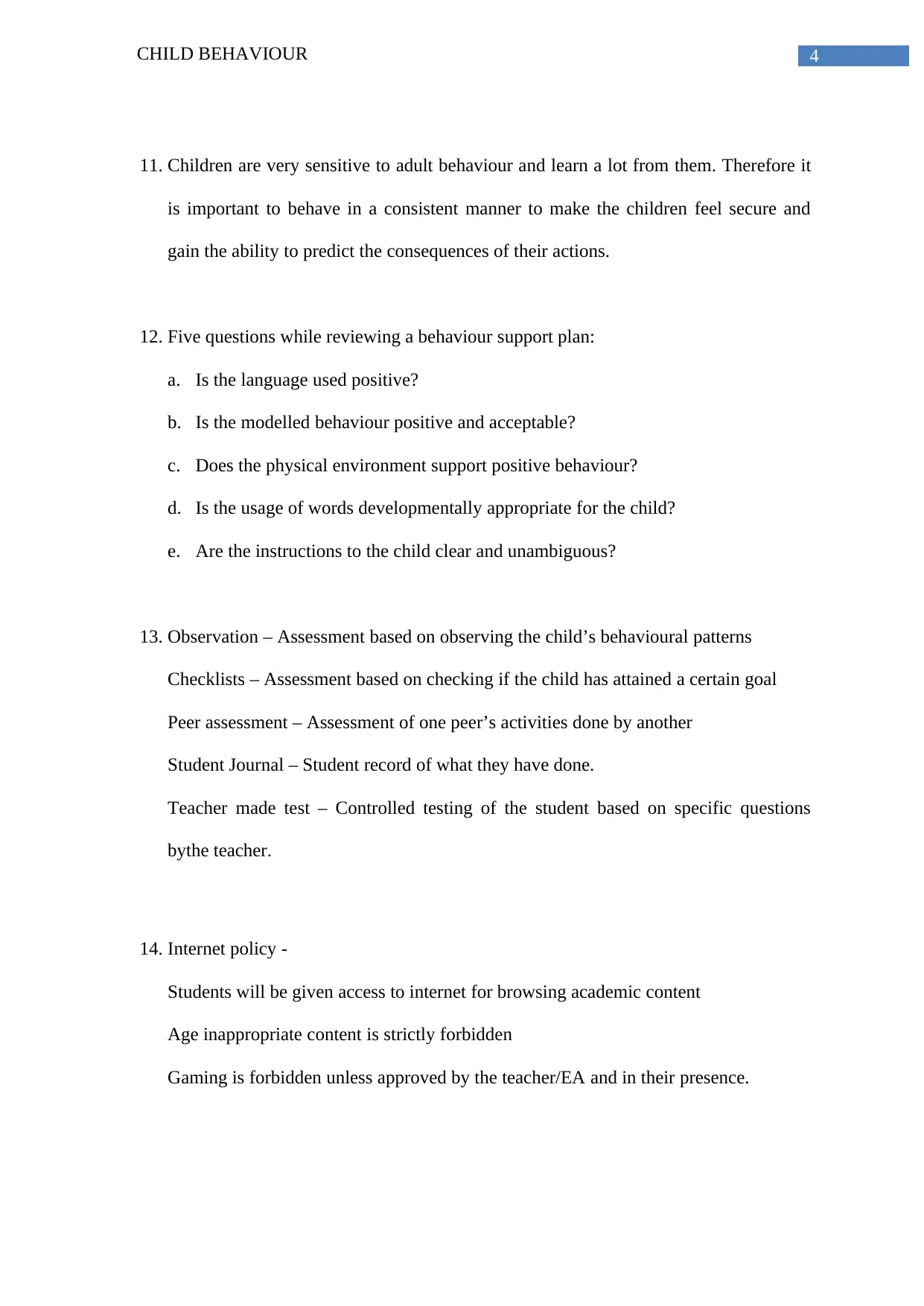
4CHILD BEHAVIOUR
11. Children are very sensitive to adult behaviour and learn a lot from them. Therefore it
is important to behave in a consistent manner to make the children feel secure and
gain the ability to predict the consequences of their actions.
12. Five questions while reviewing a behaviour support plan:
a. Is the language used positive?
b. Is the modelled behaviour positive and acceptable?
c. Does the physical environment support positive behaviour?
d. Is the usage of words developmentally appropriate for the child?
e. Are the instructions to the child clear and unambiguous?
13. Observation – Assessment based on observing the child’s behavioural patterns
Checklists – Assessment based on checking if the child has attained a certain goal
Peer assessment – Assessment of one peer’s activities done by another
Student Journal – Student record of what they have done.
Teacher made test – Controlled testing of the student based on specific questions
bythe teacher.
14. Internet policy -
Students will be given access to internet for browsing academic content
Age inappropriate content is strictly forbidden
Gaming is forbidden unless approved by the teacher/EA and in their presence.
11. Children are very sensitive to adult behaviour and learn a lot from them. Therefore it
is important to behave in a consistent manner to make the children feel secure and
gain the ability to predict the consequences of their actions.
12. Five questions while reviewing a behaviour support plan:
a. Is the language used positive?
b. Is the modelled behaviour positive and acceptable?
c. Does the physical environment support positive behaviour?
d. Is the usage of words developmentally appropriate for the child?
e. Are the instructions to the child clear and unambiguous?
13. Observation – Assessment based on observing the child’s behavioural patterns
Checklists – Assessment based on checking if the child has attained a certain goal
Peer assessment – Assessment of one peer’s activities done by another
Student Journal – Student record of what they have done.
Teacher made test – Controlled testing of the student based on specific questions
bythe teacher.
14. Internet policy -
Students will be given access to internet for browsing academic content
Age inappropriate content is strictly forbidden
Gaming is forbidden unless approved by the teacher/EA and in their presence.
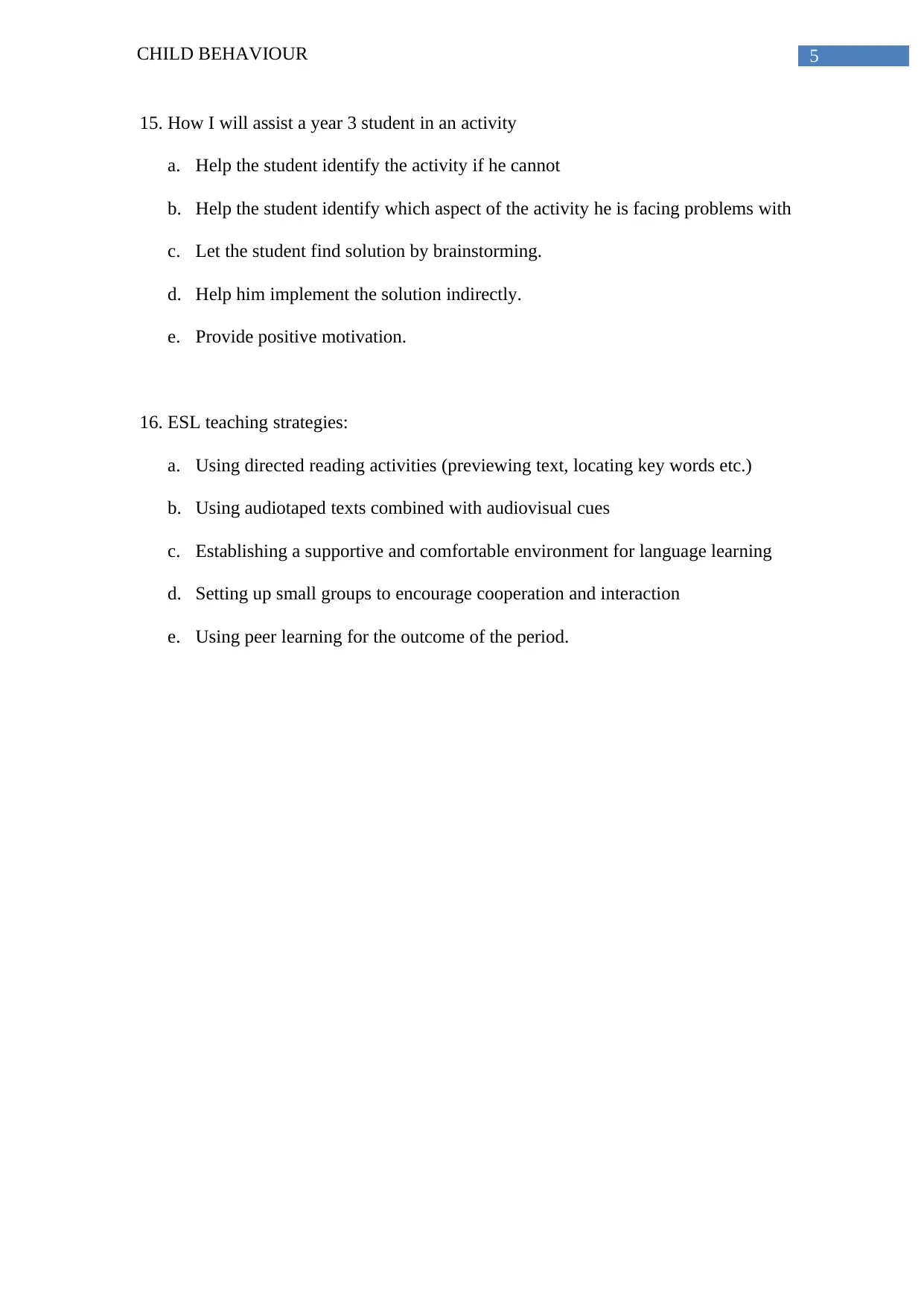
5CHILD BEHAVIOUR
15. How I will assist a year 3 student in an activity
a. Help the student identify the activity if he cannot
b. Help the student identify which aspect of the activity he is facing problems with
c. Let the student find solution by brainstorming.
d. Help him implement the solution indirectly.
e. Provide positive motivation.
16. ESL teaching strategies:
a. Using directed reading activities (previewing text, locating key words etc.)
b. Using audiotaped texts combined with audiovisual cues
c. Establishing a supportive and comfortable environment for language learning
d. Setting up small groups to encourage cooperation and interaction
e. Using peer learning for the outcome of the period.
15. How I will assist a year 3 student in an activity
a. Help the student identify the activity if he cannot
b. Help the student identify which aspect of the activity he is facing problems with
c. Let the student find solution by brainstorming.
d. Help him implement the solution indirectly.
e. Provide positive motivation.
16. ESL teaching strategies:
a. Using directed reading activities (previewing text, locating key words etc.)
b. Using audiotaped texts combined with audiovisual cues
c. Establishing a supportive and comfortable environment for language learning
d. Setting up small groups to encourage cooperation and interaction
e. Using peer learning for the outcome of the period.
⊘ This is a preview!⊘
Do you want full access?
Subscribe today to unlock all pages.

Trusted by 1+ million students worldwide
1 out of 6
Related Documents
Your All-in-One AI-Powered Toolkit for Academic Success.
+13062052269
info@desklib.com
Available 24*7 on WhatsApp / Email
![[object Object]](/_next/static/media/star-bottom.7253800d.svg)
Unlock your academic potential
Copyright © 2020–2025 A2Z Services. All Rights Reserved. Developed and managed by ZUCOL.





